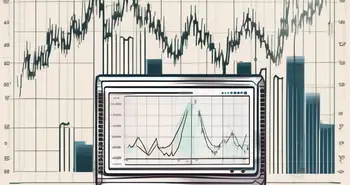The Significance of Onchain Analysis in the Cryptocurrency Market

As an expert in the exciting world of crypto trading, I am thrilled to present to you the ultimate guide to onchain analysis. In this comprehensive article, we will dive into the basics of onchain analysis, explore the importance of this analytical tool in crypto trading, delve deeper into understanding onchain data, discuss popular onchain analysis tools, and provide strategies for effective analysis. So, fasten your seatbelts, because we are about to embark on a fascinating journey!
Understanding the Basics of Onchain Analysis
What is Onchain Analysis?
At its core, onchain analysis refers to the process of examining and interpreting blockchain data to gain insights into cryptocurrency transactions and patterns. By analyzing data derived directly from the blockchain, we can track the movement of funds, identify wallets, measure the supply and demand dynamics, and assess investor behavior. This form of analysis provides valuable information about market trends, helps to predict price movements, and allows traders to make informed investment decisions.
Importance of Onchain Analysis in Crypto Trading
Onchain analysis is a crucial tool for any serious crypto trader. It enables us to better understand the dynamics of the market and make informed decisions based on real-time data. By analyzing onchain data, we can identify whale movements, detect market manipulation, and anticipate potential price shifts before they occur. Onchain analysis serves as a reliable indicator of market sentiment, allowing us to respond effectively to changing market conditions and maximize our trading profits.
Key Terms in Onchain Analysis
Before we delve deeper into the world of onchain data, let's familiarize ourselves with some key terms:
- Wallet Addresses: Unique identifiers associated with digital wallets where cryptocurrencies are stored.
- Transaction Volume: The total number of transactions executed in a given period.
- Transaction Value: The total value of cryptocurrencies transacted within a specific timeframe.
- UTXO (Unspent Transaction Output): The output of a cryptocurrency transaction that has not yet been used as input for another transaction.
- Dust Transactions: Tiny transactions with minimal value that are typically used for spam or testing purposes.
Now that we have a solid foundation in onchain analysis, let's continue our exploration by diving deeper into onchain data.
Diving Deeper into Onchain Data
Types of Onchain Data
Onchain data encompasses a wide range of information that provides valuable insights into the cryptocurrency market. Some crucial types of onchain data include:
- Transaction History: A detailed record of all transactions made on the blockchain, including sender and recipient addresses, transaction amounts, and timestamps.
- Wallet Balances: The current balance of cryptocurrencies held in a specific wallet address.
- Network Health Metrics: Data related to the overall health and performance of the blockchain network, such as block size, transaction fees, and confirmation times.
- Token Movements: Information about the movement of specific tokens, including large transfers, token burns, and token distributions.
Interpreting Onchain Data
Interpreting onchain data requires a keen sense of analysis and an understanding of market dynamics. By analyzing transaction volumes, one can gauge the level of trading activity and assess market liquidity. Similarly, tracking large transfers and whale movements helps to identify market trends and potential price manipulations. Moreover, monitoring wallet balances can provide insights into investor sentiment and the accumulation or distribution of certain cryptocurrencies.
Onchain Data and Market Trends
The analysis of onchain data is instrumental in identifying emerging market trends and predicting future price movements. By analyzing transaction history, wallet balances, and token movements, we can decipher patterns that indicate market sentiment. This knowledge allows us to stay ahead of the curve, spot investment opportunities, and mitigate risk. Remember, the ability to accurately interpret onchain data is a key skill that can greatly enhance your trading strategy.
Tools for Onchain Analysis
Popular Onchain Analysis Tools
To aid us in onchain analysis, various tools have emerged to simplify the process and provide valuable insights. Some popular onchain analysis tools worth exploring include:
- Blockchain Explorer: A tool that allows users to browse and explore the blockchain, providing access to transaction history, wallet balances, and network health metrics.
- Onchain Data Platforms: Online platforms that aggregate and analyze onchain data, providing users with comprehensive dashboards, market insights, and customizable metrics.
- TradingView: An intuitive charting platform that offers a wide range of technical analysis tools, including onchain data indicators, to help traders make informed decisions.
Choosing the Right Onchain Analysis Tool
When selecting an onchain analysis tool, it is crucial to consider factors such as reliability, accuracy, ease of use, and the specific features it offers. Each tool has its strengths and weaknesses, so it is essential to align the tool's capabilities with your trading objectives. Additionally, exploring multiple tools and comparing their functionalities can help you make an informed decision and ensure you have the necessary insights to enhance your trading strategy.
Utilizing Tools for Effective Analysis
Once you have chosen your preferred onchain analysis tool, it's time to put it to good use. Regularly monitoring transaction history, wallet balances, and market trends via the selected tool enables you to stay ahead of the game. By utilizing these tools effectively, you can identify buying or selling opportunities, track market sentiment, and optimize your trading decisions. It's important to remember that onchain analysis tools are powerful aids, but they are just one component of a comprehensive trading strategy.
Strategies for Onchain Analysis
Developing an Onchain Analysis Strategy
Now that we have covered the basics of onchain analysis and explored the various tools available, let's discuss strategies for effective analysis. Developing a robust onchain analysis strategy involves:
- Setting Clear Objectives: Define your goals and objectives, whether they are to identify potential trading opportunities, track market sentiment, or detect market manipulations.
- Establishing Key Metrics: Determine the specific onchain data metrics that align with your objectives and provide meaningful insights into the market.
- Continuous Learning: Stay up-to-date with the latest trends, news, and market developments to refine your analysis and adapt to changing market conditions.
- Combining Onchain Analysis with Technical Analysis: Integrate onchain analysis with other technical analysis indicators to strengthen your trading strategy and increase the accuracy of your predictions.
Common Mistakes to Avoid in Onchain Analysis
While onchain analysis can be a powerful tool, it is crucial to avoid common pitfalls that can undermine its effectiveness. Some common mistakes to watch out for include:
- Overreliance on Onchain Data: Onchain analysis should be used as part of a comprehensive trading strategy and not solely relied upon for decision-making.
- Ignoring Fundamental Analysis: Onchain data provides valuable insights, but always consider the broader market context and external factors that might impact the crypto market.
- Lack of Patience: Onchain analysis requires patience and a long-term perspective. Avoid making hasty decisions based on short-term fluctuations.
Improving Your Onchain Analysis Skills
Like any skill, onchain analysis requires practice and constant improvement. Stay engaged with the crypto community, join online forums, and participate in discussions to learn from experienced traders. Continuously refining your onchain analysis skills will enable you to stay ahead of the curve and take advantage of new opportunities as they arise.
Now that we have covered the essentials of onchain analysis, let's revisit the main points with some frequently asked questions.
Frequently Asked Questions (FAQ)
What is onchain analysis?
Onchain analysis involves examining and interpreting blockchain data to gain insights into cryptocurrency transactions and patterns. By analyzing onchain data, we can track the movement of funds, identify wallets, measure supply and demand dynamics, and assess investor behavior.
Why is onchain analysis important?
Onchain analysis is crucial in crypto trading as it provides valuable information about market trends, helps to predict price movements, and allows traders to make informed investment decisions. It enables us to better understand the dynamics of the market and respond effectively to changing market conditions.
What are the key terms in onchain analysis?
Some key terms in onchain analysis include wallet addresses, transaction volume, transaction value, UTXO, and dust transactions. Familiarizing yourself with these terms is essential to understand and interpret onchain data accurately.
What tools can I use for onchain analysis?
There are various tools available for onchain analysis, including blockchain explorers, onchain data platforms, and charting platforms like TradingView. Choosing the right tool depends on factors such as reliability, accuracy, ease of use, and the specific features you require.
What are some common mistakes to avoid in onchain analysis?
Some common mistakes to avoid in onchain analysis include overreliance on onchain data, ignoring fundamental analysis, and lacking patience. Onchain analysis should be used as part of a comprehensive trading strategy, considering the broader market context.
By mastering the art of onchain analysis, you can enhance your trading skills, make more informed decisions, and navigate the ever-changing crypto market with confidence. Remember, practice makes perfect, and continuous improvement is the key to success. Happy analyzing!
Ready to take your onchain analysis to the next level? Look no further than Morpher, the revolutionary trading platform that integrates seamlessly with the strategies you've just learned. With Morpher, you can trade cryptocurrencies and a multitude of other assets with zero fees, infinite liquidity, and the safety of a non-custodial wallet. Whether you're looking to invest fractionally, short sell, or leverage your trades up to 10x, Morpher offers a unique and innovative trading experience on the Ethereum Blockchain. Sign Up and Get Your Free Sign Up Bonus today to transform the way you trade and invest, all while harnessing the insights gained from onchain analysis.

Disclaimer: All investments involve risk, and the past performance of a security, industry, sector, market, financial product, trading strategy, or individual’s trading does not guarantee future results or returns. Investors are fully responsible for any investment decisions they make. Such decisions should be based solely on an evaluation of their financial circumstances, investment objectives, risk tolerance, and liquidity needs. This post does not constitute investment advice.

Painless trading for everyone
Hundreds of markets all in one place - Apple, Bitcoin, Gold, Watches, NFTs, Sneakers and so much more.

Painless trading for everyone
Hundreds of markets all in one place - Apple, Bitcoin, Gold, Watches, NFTs, Sneakers and so much more.









